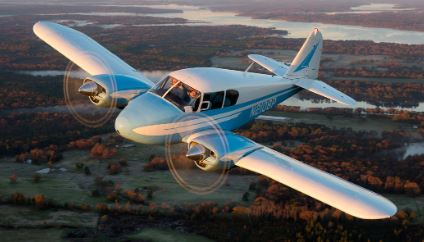
The Piper Apache Aircraft
Introducing the Piper Apache, an aircraft that helped set the stage for future innovations in light twin-engine aviation. While manufactured by the Piper Aircraft Corporation, the Apache was first introduced in 1954, designed for general aviation use, providing private pilots with a comfortable, reliable, and affordable twin-engine aircraft.
Moreover, the Piper Apache's arrival on the aviation scene marked a significant point in history. For the most part, the aircraft's accessible cost and versatility set it apart, making twin-engine flying more attainable for a broad spectrum of pilots.
HISTORY
Firstly, the development of the Piper Apache had its beginnings in the late 1940s when Piper acquired the rights to the Stinson 108 Voyager. They sought to produce a twin-engine, four-seat aircraft based on the Voyager's design. Finally, the Apache underwent several design modifications, and the first production model rolled off the assembly line in 1954.
DESIGN
Specifically, the Apache's design was optimized for its role as a light twin-engine aircraft. With a wingspan of 37 feet and a length of 27 feet, the aircraft had a maximum takeoff weight of 2,900 lbs. Since the cabin was designed to comfortably accommodate four passengers, it included individual seats for a pilot and co-pilot and a bench seat in the back for passengers.
PERFORMANCE
While powered by two Lycoming O-320 engines, the Piper Apache boasted a top speed of 150 knots. On the whole, the aircraft's cruising speed was around 132 knots, with a range of 780 miles. Finally, it could climb up to 17,000 feet, offering pilots ample altitude for cross-country flights.
TECHNOLOGY
One of the defining features of the Piper Apache was its simplicity and reliability. Further, the aircraft utilized conventional technologies available at the time of its production. However, some models featured a unique feature – the Lycoming O-320-B2B engines, which had the ability to run on lower-octane fuel, a significant advantage during the era of its production.
VARIANTS
Over the years, the Apache spawned a number of variants. The PA-23-160 Apache E was a more powerful version, equipped with 160 hp engines. The PA-23-235 Apache H model was powered by 235 hp engines, which provided significantly improved performance. Comparatively, another notable variant was the Piper Aztec, a further development of the Apache, featuring a longer nose, six-seat capacity, and more powerful engines.
OPERATORS
The Piper Apache has been widely used by flight schools and private owners around the world due to its reliability, ease of operation, and affordable maintenance costs. Therefore, it has proven itself as a great trainer aircraft, particularly for multi-engine rating training.
To conclude, the Piper Apache undeniably holds a significant place in aviation history. Undoubtedly, its design, performance, and affordability made twin-engine flying more accessible, thus broadening the landscape of general aviation. What's more, share this fascinating piece of aviation history with others and keep the spirit of the Piper Apache alive!
Specifications and Performance Data
| Category | Details |
|---|---|
| Manufacturer | Piper Aircraft |
| First Flight | 1952 |
| Introduced | 1954 |
| Length | 27 feet |
| Wingspan | 37 feet |
| Max Takeoff Weight | 2,900 lbs |
| Seating Capacity | 4 |
| Powerplant | 2 × Lycoming O-320, 150 hp each |
| Cruise Speed | 132 knots |
| Top Speed | 150 knots |
| Range | 780 miles |
| Service Ceiling | 17,000 feet |
This article uses material from various web resources and Wikipedia article, released under the Creative Commons Attribution-Share-Alike License 3.0.

